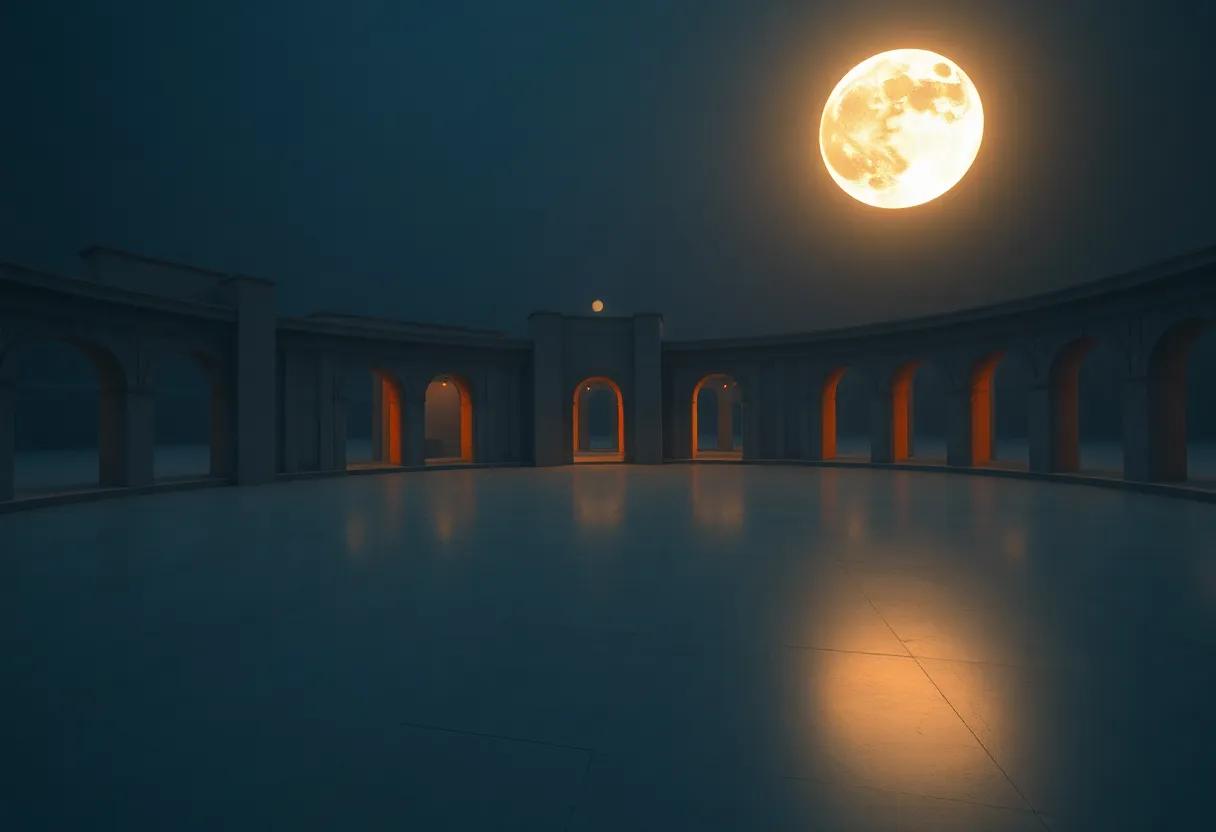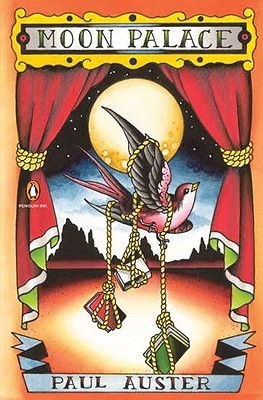In the vast landscape of contemporary literature, few novels delve as intricately into the labyrinth of identity and destiny as Paul AusterS Moon Palace. With its layered narrative and introspective prose, the book invites readers on a contemplative journey through the intersections of fate, family, and self-revelation. This review seeks to illuminate the ways in wich Auster weaves these themes together, offering a thoughtful exploration of a work that challenges and enriches our understanding of the human experience.
Unraveling the Layers of Identity in Moon Palace Through the Eyes of Its Protagonist

At the heart of Moon Palace lies an exploration of identity as fluid and layered,shaped by memory,loss,and the passage of time.The protagonist’s journey is not merely geographical but a profound internal excavation, where each encounter and revelation reshapes his understanding of self. His identity unfolds like a palimpsest, overwritten by family secrets and personal struggles, reflecting how fate intertwines with choice in the formation of who we become. This nuanced viewpoint challenges readers to consider that identity is less a fixed destination and more a constellation of shifting experiences and inherited narratives.
The novel’s complex portrayal of identity can be broken down into essential elements that echo throughout the protagonist’s story:
- Heritage and Family Legacy: The discovery of ancestral roots alters his self-perception,illustrating how much of identity is inherited and how much is constructed.
- Isolation and Connection: Moments of solitude contrast with deep interpersonal bonds, emphasizing the tension between independence and belonging.
- Memory’s Role: Fragmented memories act as both bridges and barriers to understanding himself,underscoring the subjective nature of identity.
| Layer of Identity | Manifestation | Impact on Protagonist |
|---|---|---|
| Family Secrets | Sudden revelations | Redefines world view |
| Self-Discovery | Travel and solitude | Encourages introspection |
| Historical Memory | Inherited stories | Shapes identity framework |
The Intricate Role of Fate and Chance Interwoven throughout Paul Auster’s Narrative

In Paul auster’s Moon Palace, the delicate dance between fate and chance emerges as a pivotal force guiding the protagonist’s journey, yet this is no mere coincidence or random twist of events. Instead, it is a carefully choreographed interplay that shapes identity itself, reflecting the unpredictable nature of existence. From the serendipitous discovery of his estranged family lineage to the near-fateful encounters that push him to reassess his understanding of self,fate and chance act less as external disruptors and more as internal catalysts,stirring the depths of memory and self-reflection. Auster’s narrative subtly suggests that identities aren’t static but rather fragile constructs continuously molded by the unexpected intersections of life’s hidden patterns.
This intertwining of destiny and randomness can be visualized as a complex web where each thread holds meaning, yet their interrelations remain elusive.Consider the ways key moments in the novel rely on elements beyond the protagonist’s control, emblematic of the larger philosophical assertion that human lives are perpetually negotiating between agency and the uncontrollable tides of fortune. As an example:
- Encounters: Chance meetings that reignite the past and redefine future paths.
- Lost artifacts: Objects symbolizing fate’s cryptic messages embedded within memory.
- Geographical shifts: The navigation between urban landscapes and wilderness reflecting internal and external uncertainty.
| Element | Role in narrative | Symbolism |
|---|---|---|
| the Coin Toss | Decides immediate action | Chance as a metaphor for uncertainty |
| Family Letters | Revelation of identity | Fate’s hidden truth |
| Train Journeys | Transitions in life phases | Life’s unpredictable movement |
how Settings Reflect Inner Turmoil and Personal Growth in Moon Palace

In Moon Palace, the physical environments are more than mere backdrops; they serve as mirrors to the protagonist’s internal struggles.The shifting urban landscapes of New York, juxtaposed with the vast deserts of the American West, embody the oscillation between chaos and clarity within the narrator’s mind.The cramped, cluttered cityscapes reflect moments of confusion and constriction, while the expansive, open settings symbolize the yearning for freedom and self-discovery. This intentional use of setting crafts a layered narrative where place becomes an extension of emotional and psychological state, inviting readers to explore how surroundings shapes-and is shaped by-personal turmoil.
Key settings and their symbolic meanings include:
- The Metropolitan Maze: Illustrates entrapment in societal expectations and internal conflict.
- Desert Expanse: Represents isolation but also the potential for transformation and rebirth.
- Family Homes: Evoke memories and unresolved tensions that fuel the protagonist’s quest for identity.
| Setting | Emotional Tone | narrative Impact |
|---|---|---|
| The City Streets | Confusion, Isolation | Highlighting disorientation and loss |
| Grand Canyon | Solitude, Reflection | Spaces for introspection and change |
| Family Estate | Nostalgia, Uncertainty | Confronting the past to shape identity |
Symbolism and Motifs That Enhance the Philosophical depth of the Novel

Throughout Paul Auster’s Moon Palace, symbolism and recurring motifs weave an intricate tapestry that amplifies the novel’s philosophical undertones. The motif of the moon itself serves as a celestial beacon of destiny and transformation, reflecting protagonist Marco Stanley Fogg’s evolving identity and search for meaning. The moon’s shifting phases resonate with themes of cyclical existence and the interplay between light and shadow within the self. Similarly, the sprawling, labyrinthine landscapes of New York City parallel Marco’s internal quest, embodying both confinement and infinite possibility, a metaphor for the human condition marked by chance and choice.
Auster also deftly employs objects and events as symbols that ripple through the narrative, imbuing the story with layered significance:
- The White Whale: an echo of literary obsession and the elusiveness of truth.
- Photographs: Fragments of memory anchoring identity across time.
- Flickering Fire: impermanence and the fragile nature of existence.
- Genealogy and Ancestry: The inescapable currents of fate flowing through bloodlines.
| Symbol | Philosophical Meaning | Effect on Identity |
|---|---|---|
| Moon | Cycles of life and destiny | Constant self-reinvention |
| White Whale | Obsession and truth’s elusiveness | Quest for understanding |
| Photographs | Memory and time | Anchoring identity |
By intertwining these symbols with the characters’ journeys, Auster invites readers to contemplate how identity is shaped not only by personal choices but also by a web of external influences and hidden patterns-ultimately questioning whether fate is a guiding force or a construct of our own making.
Analyzing the Relationship Dynamics That Shape the Hero’s Journey and Self-Discovery

Within Moon Palace, relationships act as both mirrors and molders of the protagonist’s evolving identity. The interplay between characters is not merely incidental but foundational to the protagonist’s quest.Through his connections - frail or steadfast – the novel reveals how self-discovery is often sparked by the reflection of others’ narratives. These relationships become a tapestry, showing that our understanding of self grows in tandem with the people who surround us. Notably compelling is the nuanced dynamic with paternal figures,which encapsulates both conflict and reconciliation,shaping the hero’s internal landscape and pushing the boundaries of his fate.
Analyzing the relational currents, we observe several key themes that surface repeatedly:
- Intergenerational Influence: The reverberations of ancestry and unfinished legacies.
- Identity as Fluid: How interactions dismantle fixed notions of self.
- Fate and Choice: The tension between predetermined paths and personal agency.
| Relationship Type | Impact on Hero’s Journey |
|---|---|
| Paternal | Catalyst for confrontation and reconciliation |
| Friendship | Support system and reality check |
| Romantic | Emotional growth and vulnerability |
The Influence of Historical Context and Cultural References on the Story’s Texture
Paul Auster’s Moon Palace is deeply interwoven with a tapestry of historical events and cultural undercurrents that amplify its narrative texture.The novel oscillates between the personal and the historical, creating a dialog between the protagonist’s identity crisis and the broader American cultural landscape. From the lingering shadows of the 1960s political unrest to references of classic American literature,the story reflects an era where fate and self-discovery were often shaped by societal forces beyond individual control. This intricate layering invites readers to consider how external contexts-from the Moon landing to the Vietnam War-become inextricable from the protagonist’s internal journey, transforming history into an almost palpable presence within the novel’s psyche.
Moreover, the cultural allusions embedded in the text operate as a subtle guide through the protagonist’s evolving sense of self, connecting him with a collective American consciousness. The novel features a rich constellation of symbols and motifs, such as:
- Jazz and musical references – evoking themes of improvisation and identity fluidity
- Mythological echoes - lending a timeless quality to the protagonist’s quest
- Urban landscapes – reflecting the fragmented realities of modern existence
These elements work subliminally to create a textured fabric of meaning that extends beyond the central narrative. The layering feels almost cartographic, mapping a journey that is as much about history and culture as it is indeed about personal fate, knitting together a story where every element resonates with the pressures and possibilities inherent in the American dream.
Narrative Style and structure as Tools for Exploring Memory and Destiny
Paul Auster’s Moon Palace masterfully employs a narrative approach that echoes the fragmented nature of human memory. The story unfolds through a first-person perspective that mimics the meandering logic of reminiscence-blending past and present with a fluidity that invites readers to piece together the protagonist’s identity like a puzzle. This nonlinear structure, rife with flashbacks and philosophical digressions, serves as more than just a stylistic choice; it becomes a vehicle through which the elusive relationship between memory and destiny is explored. By weaving together disparate moments, Auster captures the essence of how personal histories shape the trajectories of our lives, emphasizing that memory is both a source of clarity and confusion.
Additionally, the novel’s architecture can be viewed through the lens of fate’s unpredictability. The episodic chapters function almost like signposts, guiding the protagonist-and readers-through a labyrinth of coincidences and revelations. Auster’s use of repetitive motifs and mirrored events underlines the idea that certain paths seem preordained, yet remain subject to personal interpretation and change. Below is a brief breakdown of these structural elements and their narrative functions:
| Structural Element | Narrative Function |
|---|---|
| Nonlinear Timeline | Reflects fragmented memory and connects past to present |
| Flashbacks | Reveal hidden motivations and deepen character backstory |
| Repetitive Motifs | Emphasize cycles of fate and recurring themes |
| Mirrored Events | Highlight parallels between characters’ choices and destinies |
Through this intricate interplay of narrative devices, Moon Palace transcends a mere coming-of-age tale, transforming into a meditation on how memory does not just preserve our past but also subtly scripts our future. The storytelling becomes an exploration space where destiny is neither fixed nor random,but a delicate dance informed by the stories we choose to tell ourselves.
Emotional Resonance and the Evocation of Solitude in Auster’s Prose
Paul Auster’s prose is a delicate dance of raw emotion and contemplative solitude, weaving an immersive tapestry where loneliness becomes almost palpable. His characters often navigate vast internal landscapes, reflecting a profound sense of isolation that transcends mere physical separation. Through his thoughtful, measured language, Auster invites readers to inhabit these quiet spaces of introspection, cultivating a connection that resonates deeply within the human experience. This emotional undercurrent is not simply a backdrop, but a vital force driving the narrative forward-each moment of solitude is laden with meaning, shaping identity and destiny in subtle, yet unmistakable ways.
The evocation of solitude in Moon Palace manifests through recurring motifs and structural choices that amplify the introspective quality of the narrative. Auster’s use of pauses and reflective silences allows readers to breathe alongside his protagonist, creating a rhythm that mimics the ebb and flow of contemplative solitude. Key elements that enrich this emotional resonance include:
- Spatial isolation: Settings that symbolize both physical and psychological separation.
- Temporal displacement: Moments where time seems suspended, emphasizing internal conflict.
- Symbolic objects: Items that carry emotional weight and memories, anchoring solitary reflection.
- Conversational silences: Unspoken thoughts that reveal deeper layers of loneliness and connection.
| Element | Function | Impact on Reader |
|---|---|---|
| Spatial Isolation | Roots character in solitude | Creates empathy and introspection |
| Temporal Displacement | Suspends action and immerses thought | Heightens emotional engagement |
| Symbolic Objects | Connect past and present emotions | Deepens symbolic meaning |
| Conversational Silences | Highlights unspoken struggles | Encourages personal reflection |
Critical Comparisons Between Moon Palace and Other Works by Paul Auster
While Moon Palace shares Paul Auster’s signature themes of chance, identity, and the randomness of fate, it diverges notably in style and narrative focus from his earlier works like The New York Trilogy and Smoke.Unlike the metafictional puzzles and urban labyrinths of The New york Trilogy, Moon Palace unfolds through a more linear and emotionally intimate journey, emphasizing the protagonist’s quest for self-discovery over external enigmas. This novel’s rich historical backdrop and multi-generational scope offer a broader canvas, infusing a sense of epic storytelling that contrasts with Auster’s typically claustrophobic, detective-style narratives.
Additionally,whereas books such as Smoke explore the fluidity of identity through the lens of fragmented storytelling and ambiguous characters,Moon Palace presents a more grounded and tangible exploration of fate as an interwoven thread binding the characters’ lives. The connection between personal history and destiny takes a forefront role here,enhanced by Auster’s use of coincidence and symbolism. To better illustrate these differences, the table below compares key narrative elements across selected works:
| Element | Moon Palace | The New York Trilogy | Smoke |
|---|---|---|---|
| Narrative Style | Linear and immersive | Fragmented and metafictional | Interwoven stories with shifting perspectives |
| Theme Focus | Identity through family and history | Existential puzzles and identity | Memory and storytelling |
| Setting | Wide-ranging, spanning decades | Urban, New York City | Urban, largely Brooklyn |
| Emotional Depth | Highly introspective and poignant | Philosophical and cerebral | Reflective but more detached |
Recommendations for Readers Seeking Thought-Provoking and Philosophical Fiction
For those intrigued by narratives that delve deep into the labyrinth of self-discovery and metaphysical musings, Paul Auster’s Moon Palace offers an enriching journey. His fluid storytelling bridges the gap between existential inquiry and heartfelt human experiences, inviting readers to ponder questions around fate, chance, and identity. Engaging with this novel is akin to wandering through a beautifully crafted puzzle-each chapter revealing layers that challenge one’s understanding of destiny and personal history.
To complement the reflective atmosphere cultivated by Auster, consider works that blend philosophical undertones with compelling character studies. Here are some carefully selected recommendations that resonate with similar themes and profound questions:
- Slaughterhouse-Five by Kurt Vonnegut – a meditation on free will and the absurdity of existence.
- Norwegian Wood by Haruki Murakami – exploring memory, loss, and the complexities of youth.
- The Stranger by Albert Camus – a classic portrayal of existential alienation.
- White Noise by Don DeLillo - a postmodern reflection on death and media-saturated life.
| Book | Philosophical focus | Why It Resonates |
|---|---|---|
| Moon Palace | Identity, Fate | Interwoven personal and cosmic reflections. |
| Slaughterhouse-Five | Free Will, Absurdity | Nonlinear narrative challenges linear time. |
| The Stranger | Existential Alienation | Explores meaninglessness with stark clarity. |
| Norwegian Wood | Memory, Loss | Emotional depth blended with philosophical introspection. |
Why Moon Palace Remains a Timeless Exploration of Human existence and Belonging
At its core, Moon Palace delves deeply into the human quest for meaning, weaving a narrative that transcends generations and social boundaries. The novel’s protagonist navigates a labyrinth of personal loss and discovery, uncovering the delicate threads that connect identity, history, and destiny. What makes the story timeless is its raw honesty about the fragmentation of self and the universal longing to belong – whether that be to a family, a culture, or a larger cosmic order. Auster’s prose captures this delicate balance with subtlety, inviting readers to reflect on their own places within the vast tapestry of existence.
Moreover, the novel’s exploration of fate versus free will is neither preachy nor conclusive, but rather an open-ended meditation expressed through memorable characters and symbolic encounters. This dynamic interplay is mirrored in the following conceptual contrasts:
| Theme | Depiction in Moon palace |
|---|---|
| Identity | Fluid and evolving, shaped by memory and circumstance |
| Belonging | Elusive, often found in unexpected relationships |
| Fate | Ambiguous, challenging the notion of predetermined paths |
| Existence | A continuous search for meaning amid chaos |
- Timeless themes that resonate across cultures and eras
- Complex emotional landscapes that foster deep empathy
- Layered symbolism that rewards thoughtful interpretation
This intricate dance of ideas ensures that Moon Palace remains a profound and poignant exploration of what it means to be human, inviting each reader to engage with their own identity and destiny long after the final page.
Insight Into Paul Auster’s Life and Literary Contributions That Shaped Moon Palace
Paul Auster’s life is as layered and intricate as his celebrated novel Moon Palace. Born in 1947 in Newark, New Jersey, Auster’s experiences as a translator, writer, and wanderer deeply inform the philosophical underpinnings of his work.His fascination with identity, chance, and coincidence is not merely literary-it stems from a personal quest marked by family loss, geographic dislocation, and a profound engagement with existential questions. This rich backdrop breathes life into the novel’s protagonist, Marco Stanley Fogg, embodying Auster’s exploration of selfhood amid the unpredictability of fate.
Literary contributions from Auster go beyond simple storytelling. His style blends elements of noir, metafiction, and classic American storytelling, which challenge readers to navigate a labyrinth of meaning and interpretation. Auster’s narrative techniques are characterized by:
- Interwoven narratives that reflect the fragmented nature of memory and history
- Philosophical musings about destiny and free will
- symbolic motifs such as the moon, which recur as metaphors for cycles and renewal
This creative synthesis culminates in Moon Palace, a novel that serves as both a personal testament and a universal meditation on the forces shaping human lives.
| Aspect | Influence on Moon palace |
|---|---|
| Family and Loss | Shapes protagonist’s search for identity |
| New York Setting | Backdrop reflecting change and decay |
| Philosophy & myth | Intertwined themes of fate and existence |
| Literary Style | Fusion of realism and metafiction |
Moon Palace offers more than just a story-it invites readers to embark on an introspective journey through the labyrinth of identity and the unpredictable currents of fate. Paul Auster’s intricate narrative weaves a tapestry that is at once intimate and expansive, leaving us to ponder the threads that bind us to our past, and the paths that lead us forward.Whether viewed as a meditation on coincidence or a search for selfhood, this novel lingers long after the final page, quietly urging us to reflect on the stories that shape our own lives.












